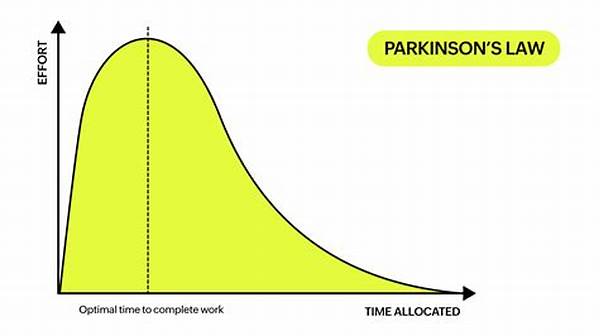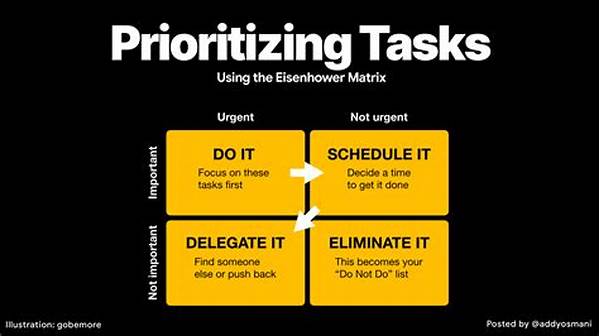Breaking Down Parkinson’s Law in Modern Work
In the bustling world of deadlines and multitasking that defines today’s work culture, the words of Cyril Northcote Parkinson echo louder than ever: “Work expands to fill the time available for its completion.” This simple observation, known as Parkinson’s Law, captures a paradox that many of us wrestle with daily. Why does a task that could take two hours extend to fill an entire afternoon? It’s time we took a closer look at breaking down Parkinson’s Law in modern work, not just to understand it, but to master it.
Read More : Remote Workers Share Secrets To Staying Productive
Imagine this: it’s Monday morning. A manager informs their team that a report due Friday could be submitted next week instead. Instantly, everyone relaxes, casually shuffling their priorities. Something that could have been accomplished within a tight frame now stretches over the following days, soaking up available hours. Why does this happen? Parkinson’s Law helps to articulate this curious human tendency. This fascinating insight isn’t just a quirky tidbit for conversation but a powerful lens through which we can revisit and improve our approach to productivity. It’s time to dive deeper into this and understand its implications on our modern work life comprehensively.
Engaging with the concept of breaking down Parkinson’s Law in modern work can uncover ways to reclaim control over our time. It serves as a call to action, propelling us to reconsider our preset timelines and task management strategies. Williams, the CEO of a thriving tech startup, shares how applying this principle led to unprecedented growth in efficiency within her team. With a mix of humor and pragmatism, she recounts the journey of limiting task durations and creating more structured deadlines. ‘It’s like magic!’ she exclaims. This testament isn’t just a bold statement—it’s a testament to the revolutionary potential that awaits those ready to break free from leisurely timelines and embrace a new work ethos.
Embracing Efficiency with a Modern Twist
Understanding that work will expand to fill the time allocated, savvy professionals are now seeking strategies to circumnavigate this natural tendency. By re-evaluating time allocations and compressing timelines mindfully, individuals and teams start leveraging work hours more effectively. This requires a proactive stance, introducing tools, philosophies, and perhaps even a change in the work culture, which can catalyze a shift from overextended deadlines to focused, efficient endeavors.
—
Reclaiming Time: Strategies for Breaking Down Parkinson’s Law
The quest for optimizing work processes in today’s digital age is filled with buzzwords like “efficiency” and “productivity.” Yet amidst the chaos of constant notifications and never-ending to-do lists, Parkinson’s Law reminds us of a simple truth: without precise boundaries, tasks balloon uncontrollably, draining your valuable time and energy. Breaking down Parkinson’s Law in modern work requires a committed shift towards structured task management. With an eye on ambition and efficiency, this shift is not merely academic but essential for sustained competitiveness in fast-paced industries.
The first step, as expert productivity consultants recommend, is acknowledging how often we fall prey to Parkinson’s Law. Establishing boundaries through defined working periods is one method to counteract this. By setting hard stops on tasks and respecting these limits, professionals can begin to dismantle the inefficiencies that Parkinson’s Law thrives on. Interestingly, tools and technology today can support this initiative, from project management applications to time-tracking software.
This concept isn’t just a theoretical exercise. Jean, a project manager at a bustling consulting firm, adopted these practices, sharing her observations. “Since we started setting stricter timelines, the results have been fabulous,” she reports. “Not only do we finish projects ahead of schedule, but we’ve also noticed an increase in team morale.” Jean’s testimony highlights a core truth: breaking down Parkinson’s Law in modern work enhances not only productivity but also team dynamics and job satisfaction.
Despite these positive outcomes, successfully overcoming Parkinson’s Law demands discipline and cultural adaptation within the workplace. Employers and managers must lead by example, reinforcing and celebrating strict adherence to newly set protocols and timelines. Adjusting the work culture to embrace urgency and efficiency can indeed pay dividends in ways that transcend mere task completion.
Transformative Techniques to Master Parkinson’s Law
Understanding and breaking down Parkinson’s Law in modern work environments is more than just tackling a productivity quirk. It represents an engagement with strategic time management, crucial for thriving within today’s relentless work landscape. Implementing these methods not only elevates individual output but also fosters an invigorating work culture, redefining what it means to be productive and effective in the digital age.
Strategies to Tackle Parkinson’s Law
In the realm of productivity, foresight and strategy are imperative to outsmart Parkinson’s Law. Here, implementation of decisive tactics and timely determination can meet with success. Start by instituting time constraints that challenge existing perceptions of what’s necessary to complete a task. This doesn’t mean rushing but rather pushing against the boundaries of perceived limits.
As we continue breaking down Parkinson’s Law in modern work, it becomes evident that efficiency is within reach for those willing to engage with these strategic insights. This pathway leads not only to operational excellence but opens a narrative for creating lasting and impactful change in the way work is approached and celebrated in contemporary environments.
—
Discussion Around Parkinson’s Law
1. Is Parkinson’s Law Absolute?
2. Case Studies of Successful Implementation
3. Role of Technology in Mitigating Parkinson’s Law
4. Psychological Insights Behind Parkinson’s Law
5. Interconnection Between Procrastination and Parkinson’s Law
6. Challenges in Reforming Work Cultures
7. Measuring Productivity: Before and After
8. Testimonials from Industry Leaders
9. Cultural Impacts on Parkinson’s Law Adherence
10. Future Prospects in Combating Parkinson’s Law
Dissecting Parkinson’s Law in modern work means delving into diverse perspectives and experiences. This phenomenon doesn’t solely belong to academic discussions—it’s a tangible challenge within everyday business environments. Engaging teams in discussions about breaking down Parkinson’s Law ignites transformative insights, inspiring not just adherence but evolution in work culture practices.
Breaking the invisibility cloak around Parkinson’s Law provides a primer for critically thinking about how work gets done. Through strategic dialogue, it’s possible to collectively inspire changes in both personal productivity and organizational efficiency. From here, resources and innovations implemented with clear intent can start reshaping how tasks are approached, leading to an overarching culture of dynamism and success.



